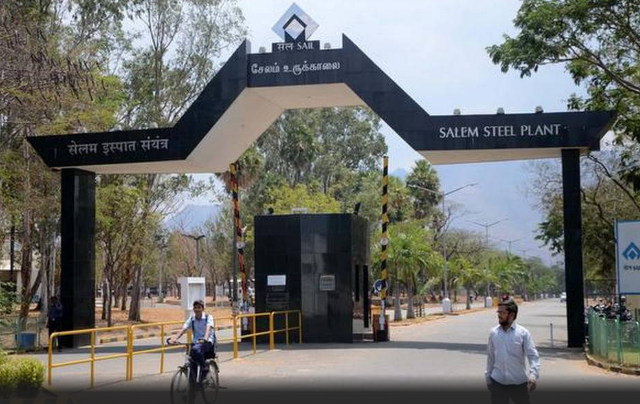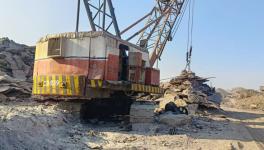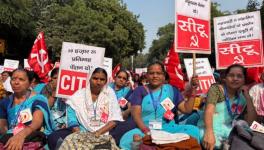Disinvestment of Salem Steel Plant: Workers Accuse SAIL for Loss of Profit

Image Courtesy: The Hindu
In two weeks time, the Salem Steel Plant (SSP), one of the special steel units of the Steel Authority of India Ltd. (SAIL), is set to receive letters from interested parties to take over the unit. Latest in the disinvestment franchise of the NDA government are the Visvesvaraya Iron and Steel Plant in Bhadravati, Karnataka and Alloy Steel Plant in Durgapur, West Bengal, along with the SSP in the name of loss of profit.
Salem Steel Plant is the only public sector company that makes high grade stainless steel in the country. All others are private players and SSP is in direct competition with the international giant Jindal group in the market. But financially, the company has been suffering losses for the past five financial years. This is the reason cited by SAIL for disinvestment of the three special steels unit. But the workers have only the SAIL management to blame for this.
From false ceilings to the flooring of rail coaches, the usage of stainless steel is vast. The SSP has a long history spanning over four decades in making stainless steel in the country.
Also read: Mission Privatisation? Government to Sell Three SAIL Plants
SSP was modernised twice to accommodate the backward integration process. This is the process through which the company integrates its operations with the supply side of the business. The steel plant established units to produce the final products and then developed facilities that were needed for the production. The company first started the cold rolling mills for production. In 1993, a new project was installed for the hard rolling mill to supplement the cold rolling mills. Then the plant developed steel melting shops which were installed in 2010. By 2011, the production began in these facilities.
The steel melting shop in SSP has the Asian record for fastest ever commissioning and production. It has a capacity of 1,80,000 ton per annum, while the hard rolling mill has a capacity of 3,54,000 ton per annum and 1,43,000 ton per annum for the cold rolling mill.
After the modernisation, the earnings from the production were going for the interest to pay off the capital investment. For the last phase of modernisation that happened in 2010, the cost was about Rs 2,500 crore. Of this, around Rs 1,000 crore was invested by the company itself while Rs 1,500 crore was from commercial borrowings. The interest for this investment amounts to about Rs 100 crore per annum. After the interest and depreciation taken into account, the numbers indicate a loss of profit for the company.
“Whenever a new facility is installed, the company takes some time to repay the investment and there will be some loss in that period. After this period of repayment, we naturally bounce back and start making profits,” said K P Suresh Kumar, the general secretary of the Steel Plant Employees’ Union affiliated with the Centre for Indian Trade Unions (CITU).
“During the period of 2006 to 2008 we have earned upto Rs 100 crore in profit. This is a common business cycle we can see in India,” he added.
Govt Focusing More on Private Companies
The foreign direct investment policies in post-liberalisation India had made the competition tough for the domestic players, said Kumar. “As far as stainless steel is concerned, the government has not imposed any minimum import price. Minimum import price is one of the ways to safeguard the domestic players. We are suffering a lot since Korea, China, and the US are dumping their products in the Indian market. There is no support for the domestic players from the government for the past six or seven years,” he said.
Also read: Vishweshwaraya Iron and Steel Ltd to be Privatised, Workers Protest
Government is not taking any steps to secure production through contracts for local consumption. Earlier, the government used to procure stainless steel from SSP for Railways and for minting the coin blanks. Now, the orders have become almost become zero. They are depending on the private companies like Jindal for their products now.
“We can definitely turn around if the government supports us,” said Suresh Kumar. “For any project there is a gestation period. We have not at all come out from the gestation period. We had our last investment in 2010 and the production started by the end of 2011. So we have got only six years so far to compensate the investment. In other units, even when the loss crosses thousands of crores, the government gives them time to recover.”
He alleged that the SSP is being treated unfairly by the SAIL management. “They consider us as a liability which is not true. We were selling more than 2 lakh ton per annum before having our own marketing division. Now, the marketing division has centralised. After that we cannot even sell one fourth of what we used to sell. We, the workers and trade unions, feel that this is a definite attempt of sabotage,” he said.
Interestingly, the details of the interest, and what SSP has paid and what is due remains undisclosed to the workers. Even the management of SSP is saying that they don’t know anything about this. “Once, the Chief Executive Officer (CEO) asked the corporate office demanding the details. They refused to disclose the information to the CEO itself. I have requested for the data through RTI twice. I even went for an appeal. But each time, they rejected my petition stating trivial reasons,” Suresh Kumar added.
Trend of Disinvestment
According to a report published in The Economic Times, the centre is planning to privatise even profit making PSUs, unlike the earlier policy of disinvesting only loss-making ones. The disinvestment target for the current fiscal year is Rs 90,000 crore. In her debut budget speech, Finance Minister Nirmala Sitharaman had stated that, “The centre is considering, in case where the PSU is still to be retained under government control, to go below 51% to an appropriate level on a case to case basis.”
Of all the disinvestments since 1991, 58% is credited to the NDA government. In the Rs. 3.63 lakh crore of disinvestments that took place since 1991, government assets worth Rs 2.1 lakh crore were disinvested in the last four years. This is almost twice the amount that were disinvested during the two terms of UPA.
In a fast growing market such as India, it is imperative for the domestic players to have strong support from the government. According to the World Steel Association (WSA), global steel demand will increase by 1.3% in 2019 and 1% in 2020. India will overtake the US as the second largest consumer of steel in 2019. They also predict that India is set to grow fastest amongst major steel consumers at 7.1% and 7.2% in 2019 and 2020, respectively. But the way SAIL is treating SSP, it will only benefit the multinational companies and corporates.
Get the latest reports & analysis with people's perspective on Protests, movements & deep analytical videos, discussions of the current affairs in your Telegram app. Subscribe to NewsClick's Telegram channel & get Real-Time updates on stories, as they get published on our website.
























